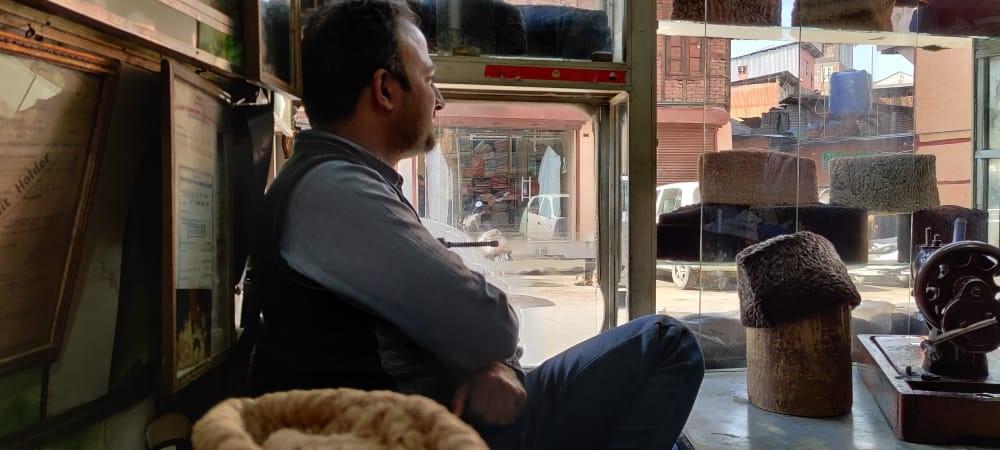(MENAFN- Kashmir Observer)

By Muneeb Naqeeb
NOT everyone can go to Hogwarts and be honoured by the Sorting hat, but in the old city of Srinagar Kashmir, a traditional hat maker has been making“Qarakul” for the world leaders and the locals alike, and the build quality is no less than magic.
The Jan family has been designing, crafting and manufacturing the esteemed Qarakul caps for about a hundred and twenty-five years today. Ever since their inception, the Qarakul caps have been an accepted symbol of prestige. The Czars fashioned it atop their scalps, as did the African monarchs and other people of such ilk.
“I make different styles of Qarakul at our shop that include caps from Russian, Turkish, Afghani, Persian, Jinnah style and I am even adapting to the contemporary styles of caps like the one worn in Ertugrul”, says Muzaffar Ahmad Jan, the owner of the shop.
From the Late Mohammed Ali Jinnah (in 1942) to Rajiv Gandhi (in 1984) to Narendra Modi (in 2014) and also to the Late King of Oman, Qaboos bin Said, the Jan Cap house has made Qarakul caps for all of them. From the political leaders like Farooq Abdullah to the separatists like Late Syed Ali Shah Geelani, the list goes on. Rumour has it that the UFC Champion Khabib as well would have been added to the list of the prominent figures whom the Jan House serves, if only the then circumstance would have allowed for the assimilation of the proper arrangements.
“Sometimes a politician specifically wants me to make his Qarakul cap taller than some rival politician. That is why I always ask about the height of the cap. I know it matters a lot,” says Jan.
It is common knowledge that the globalization of the western culture is often held responsible for the demise of our traditional attire. Jeans have conquered a lot that once used to be the culture of the land. In times like ours when the youth are swaying away from the fashion choices of their ancestors, it is no surprise that the Jan Cap House's major clients are seasoned politicians locally.
From a business perspective, Mr Jan says“The Qarakul sales locally are not what they once were, as the age-old design fails to appeal to the youth.” The Jan Cap House, however, is cashing in on the trend of the Ertugrul style Caps, which are popular among youngsters.
“I constantly try to evolve and experiment with my craft to keep up with the pace of the ever changing world', says Jan. The Qarakul cap is peaked and folds flat when taken off. With the introduction of circular caps, they have managed to dam the loss to a certain limit.
Jan is the only one from his generation of his extended family who decided to carry forward the decades-old family business. Unlike his cousins, he took up the craft of making Qarakul when his father, Ghulam Mohammad Jan, passed away.
“I never formally trained to learn this craft, it came to me naturally, and I see my 6-year-old son showing quite the similar interest in this craft”
“Earlier, I would get all of my raw material directly from Afghanistan, the quality there is superior to other places. But as fate would have it, ever since the new regime came into power there, India has stopped trading with them. So, naturally, I cannot import the material that the customers are looking for', says Jan.
On the other side of the plain, multiple animal rights organizations have raised questions about how the material that goes into the making of the Qarakul cap is procured. Where certain reports suggest that the lamb whose skin is flayed in order to obtain the material required for the making of the Qarakul is aborted as it lies in the womb, others suggest that this could not be true as the skin of the foetus is not yet developed enough to make the Qarakul. Thus, another word follows that the said lamb must be at least 5 to 6 months old (gestation period of a lamb is 152 days) to produce the quality material that is required for producing the Qarakul of sound quality.
“Had there been any inhuman practices involved in the process, I would not have been making so many Qarakul caps for religious leaders and Islamic scholars,” says Jan, pointing out that it is not only politicians who wear his sought-after headgear.
The good quality Qarakul lambskin costs around 5 to 10 thousand rupees. One skin usually makes one cap. Jan says that on average he spends around another 3000 on the raw material and labour of the cap, which usually fetches him anything in between Rs 5000 to Rs 20000. It takes him four to five hours to make a single piece and on an average he makes about two a day.
“This business runs on your eye for the skin. We get most of the skin from Afghanistan and Central Asia,” Jan says.“We tried to get some Qarakul lambs to breed in Ladakh mountains but it didn't produce very good resultsresults', he added.
Though Mr. Jan's local clientele is diminishing but the sales are not slowing down outside of the Valley.
“I keep getting requests for making Qarakul from Uttar Pradesh, Lucknow, Jaipur. People that I have never personally met, call me and place an order. I am grateful for each client that I get to have, for each sale made, I thank the Almighty.”
Follow this link to join our WhatsApp group : Join Now
MENAFN25032022000215011059ID1103912351
Legal Disclaimer:
MENAFN provides the information “as is” without warranty of any kind. We do not accept any responsibility or liability for the accuracy, content, images, videos, licenses, completeness, legality, or reliability of the information contained in this article. If you have any complaints or copyright issues related to this article, kindly contact the provider above.